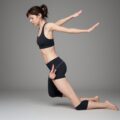Why Stretching After Walking is Important
Walking is a wonderful low-impact exercise that offers numerous health benefits. However, to truly maximize the positive effects of your walk and prevent potential discomfort, incorporating post-walk stretches into your routine is essential. Stretching after walking helps improve flexibility, reduces muscle tension, and promotes overall wellbeing. Let’s explore some gentle yet effective stretches to nourish your body after your daily stroll.
Key Benefits of Post-Walk Stretching
Before we dive into specific stretches, it’s important to understand why stretching after walking is so beneficial:
- Improves flexibility and range of motion
- Reduces muscle soreness and stiffness
- Enhances blood circulation
- Promotes relaxation and stress relief
- Helps prevent injury
- Improves posture
By taking a few minutes to stretch after your walk, you’re giving your body the care and attention it deserves, fostering a sense of overall wellbeing.
Essential Lower Body Stretches
After a walk, your lower body muscles have done most of the work. Here are some gentle stretches to show gratitude to these hardworking muscles:
1. Calf Stretch
Stand facing a wall, place your hands on the wall, and step one foot back. Keep your back leg straight and lean forward, feeling the stretch in your calf. Hold for 20-30 seconds and switch legs.
2. Quadriceps Stretch
Stand on one leg (hold onto something for balance if needed) and bring your other heel towards your buttocks. Gently grasp your ankle and hold for 20-30 seconds. Repeat on the other side.
3. Hamstring Stretch
Sit on the ground with one leg extended and the other bent. Reach towards your toes on the extended leg, feeling a gentle stretch in the back of your thigh. Hold for 20-30 seconds and switch legs.
Upper Body and Back Stretches
While walking primarily engages the lower body, your upper body and back also benefit from gentle stretching:
1. Shoulder Rolls
Stand or sit comfortably. Slowly roll your shoulders forward 5 times, then backward 5 times. This helps release tension in the neck and shoulders.
2. Chest Opener
Clasp your hands behind your back and gently lift your arms, opening your chest. Hold for 20-30 seconds, breathing deeply.
3. Gentle Spinal Twist
Sit on the ground with your legs extended. Bend your right knee and place your foot outside your left thigh. Gently twist to the right, placing your left elbow on the outside of your right knee. Hold for 20-30 seconds and repeat on the other side.
Mindful Breathing and Relaxation
As you perform these stretches, remember to breathe deeply and mindfully. This not only enhances the effectiveness of the stretches but also promotes relaxation and stress relief. Take this time to reflect on your walk, expressing gratitude for your body’s ability to move and explore the world around you.
Consider incorporating a brief meditation or moment of stillness after your stretching routine. This can help center your mind and cultivate a sense of peace and wellbeing that will carry you through the rest of your day.
Listen to Your Body
While stretching is beneficial, it’s crucial to listen to your body and respect its limits. Stretches should feel good – a gentle tension, not pain. If you experience any discomfort, ease off the stretch or try a modified version. Remember, the goal is to nurture and care for your body, not push it beyond its comfortable limits.
Everyone’s body is unique, so feel free to adapt these stretches to suit your individual needs and preferences. The most important thing is that you’re taking time to care for yourself and honor your body’s hard work.
FAQ: Essential Stretches After Walking
Q1: How long should I stretch after walking?
A1: Aim for 5-10 minutes of gentle stretching after your walk. This gives you enough time to target major muscle groups without overextending yourself.
Q2: Is it better to stretch before or after walking?
A2: While light stretching before walking can be beneficial, the best time for a more thorough stretch is after your walk when your muscles are warm and more pliable.
Q3: What if I don’t have time to stretch after every walk?
A3: Even a few minutes of stretching can be beneficial. If you’re short on time, focus on the areas that feel the tightest. Consistency is key, so try to make stretching a regular part of your routine, even if it’s brief.
Q4: Can stretching help reduce muscle soreness after walking?
A4: Yes, gentle stretching can help reduce muscle soreness by improving blood flow to the muscles and reducing lactic acid buildup.
Q5: Are these stretches suitable for everyone?
A5: While these stretches are generally safe for most people, it’s always best to consult with a healthcare professional if you have any existing health conditions or injuries. They can provide personalized advice and modifications if needed.
Remember, the journey to wellbeing is a personal one. By incorporating these essential stretches after your walks, you’re not just caring for your physical body, but also nurturing your overall sense of health and happiness. Embrace this time as a gift to yourself, a moment of self-care in your day. Happy walking, and even happier stretching!









